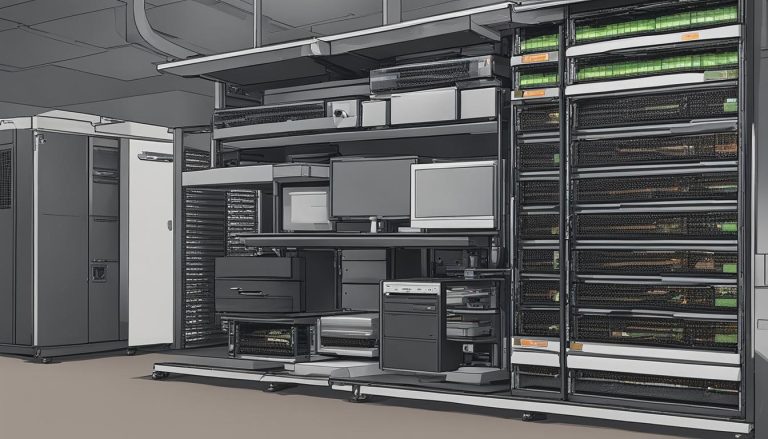In today’s digital age, technology is constantly evolving and shaping the way we work and live. One revolutionary technology that has gained considerable attention is the virtual machine (VM). Through the power of virtualization technology and the utilization of a hypervisor, a VM allows for the efficient running of multiple operating systems and applications on a single physical machine. This breakthrough in virtual computing has opened up a world of possibilities and transformed the way we approach IT infrastructure.
Key Takeaways:
- A virtual machine is a software-based emulation of a physical computer.
- It utilizes virtualization technology and is managed by a hypervisor.
- VMs allow for running multiple operating systems and applications on a single physical machine.
- Virtual machines offer scalability, flexibility, security, cost reduction, and simplified management.
- They are widely used in virtual computing, cloud computing, and virtual server environments.
How Virtual Machines Work
A virtual machine (VM) operates by providing an isolated environment for running its own operating system (guest OS) and applications. It is independent from the underlying host system and other VMs on that host. The VM is managed by a hypervisor, which acts as a bridge between the VM and the host system. The hypervisor emulates the computer’s hardware resources, such as CPU, memory, storage, and network, and allocates them to the VM as needed.
Each VM can have a different guest OS, which can be the same or different from the host OS and other VMs on the host. This allows for the simultaneous running of multiple VMs on the same physical computer, without them interfering with each other.
Virtual Machine Architecture
“A virtual machine provides an isolated environment for running multiple operating systems and applications on a single physical machine.”
– Virtualization Expert
The guest OS and applications within a VM have no direct access to the physical resources of the host system. Instead, they interact with the hypervisor, which manages the virtualized resources. The hypervisor ensures that each VM receives a fair share of the physical resources and prevents one VM from consuming excessive resources, which could impact the performance of other VMs and the host system.
Benefits of Virtual Machines
- Scalability and Flexibility: VMs offer the ability to easily expand or reduce resources based on workload demands, making them suitable for dynamic environments like cloud computing and hyper-converged infrastructure.
- Enhanced Security: VMs operate in isolated environments, providing increased security compared to physical machines. They support features like snapshots and backups, enabling easy recovery and protection against system failures.
- Cost Reduction: By consolidating multiple servers onto a single physical machine, VMs can optimize resource utilization and reduce hardware costs. They also simplify management and administration, leading to operational cost savings.
| Virtual Machines | Containers |
|---|---|
| Virtualize the entire computing environment, including the OS. | Virtualize only the OS. |
| Provide greater isolation and the ability to run different OSes. | Offer lightweight and efficient virtualization with lower overhead and faster boot times. |
| Best suited for running multiple applications together and for legacy applications. | Highly portable and commonly used for cloud-native and distributed applications. |
Benefits of Virtual Machines
Virtual machines offer several benefits that make them popular in various environments. First, they provide scalability and flexibility, allowing for easy expansion or reduction of resources based on workload demands. This makes them suitable for cloud computing and hyper-converged infrastructure.
Second, VMs offer increased security compared to physical machines, as they operate in isolated environments and support features like snapshots and backups. This ensures that sensitive data and applications are protected from unauthorized access or external threats.
Third, VMs can reduce costs by consolidating servers and optimizing resource utilization. By running multiple operating systems and applications on a single physical server, organizations can save on hardware and maintenance costs. Additionally, virtual machines simplify IT management and administration by providing self-contained environments that can run different operating systems and applications on a single server. This streamlines the deployment, maintenance, and troubleshooting processes.
| Benefits of Virtual Machines | Description |
|---|---|
| Scalability and Flexibility | Allows for easy expansion or reduction of resources based on workload demands |
| Increased Security | Operates in isolated environments and supports features like snapshots and backups |
| Cost Reduction | Consolidates servers and optimizes resource utilization |
| Simplified Management | Provides self-contained environments for running different OSes and applications on a single server |
In summary, virtual machines offer significant advantages in terms of scalability, flexibility, security, cost reduction, and simplified management. These benefits make them a preferred choice in various computing environments, including cloud computing and virtual server environments.
Comparing Virtual Machines and Containers
In the world of virtualization, two popular technologies stand out: virtual machines (VMs) and containers. While both serve the purpose of virtualizing computing environments, they have distinct characteristics and use cases. In this section, I will compare and contrast VMs and containers, focusing on containerization, overhead, portability, and isolation.
Containerization
Containers and VMs have different approaches to virtualization. VMs create an entire virtualized environment, including the operating system (OS), within a host system. This means that each VM requires its own OS installation, leading to larger file sizes and higher resource overhead. On the other hand, containers virtualize only the OS, sharing the host’s kernel and libraries. This makes containers more lightweight and efficient since they don’t need a full OS installation for each instance.
Overhead
Due to their complete virtualization approach, VMs generally have higher overhead compared to containers. VMs require more memory, storage, and CPU resources to run multiple instances of OSes simultaneously. Containers, on the other hand, have minimal overhead because they share the host’s resources and only require what is necessary to run the application. This makes containers ideal for environments that require high scalability and efficient resource utilization.
Portability and Isolation
Containers excel in terms of portability and isolation. They can be easily moved between different hosts or platforms, making them highly portable and adaptable. This is especially useful for cloud-native and distributed applications. Additionally, containers provide application-level isolation, meaning that changes or issues in one container do not affect others. VMs, on the other hand, offer stronger isolation by virtualizing the entire OS. This makes VMs more suitable for running multiple applications together and for hosting legacy or incompatible software.
| Comparison | Virtual Machines | Containers |
|---|---|---|
| Virtualization Approach | Full virtualization (including OS) | OS-level virtualization |
| Resource Overhead | Higher | Lower |
| Portability | Complex | Highly portable |
| Isolation | Strong | Application-level |
In summary, virtual machines and containers have distinct characteristics that make them suitable for different scenarios. VMs provide complete virtualization, offering strong isolation and compatibility for various operating systems. Containers, on the other hand, are lightweight, portable, and highly scalable, making them ideal for cloud-native applications. Understanding the differences between VMs and containers allows organizations to choose the most appropriate virtualization technology for their specific needs.
Conclusion
In conclusion, virtual machines are a fundamental component of modern technology. They offer the capability to run multiple operating systems and applications on a single physical machine, thanks to virtualization technology. Managed by a hypervisor, virtual machines provide numerous benefits to various computing environments.
Virtual machines are integral to cloud computing, as they enable scalability and flexibility in resource allocation, allowing for easy expansion or reduction based on workload demands. Additionally, they enhance security by operating in isolated environments with features like snapshots and backups.
Cost reduction is another advantage of virtual machines, achieved by consolidating servers and optimizing resource utilization. Furthermore, they simplify IT management and administration by providing self-contained environments capable of running different operating systems and applications on a single server.
Virtual machines continue to play a pivotal role in today’s technology landscape. While containers have grown in popularity, virtual machines provide a level of isolation and compatibility with different operating systems that make them indispensable for running multiple applications and legacy systems. By understanding the concept and advantages of virtual machines, organizations can make informed decisions to leverage this technology in their computing environments.
FAQ
What is a virtual machine?
A virtual machine, also known as VM, is a software-based emulation of a physical computer that allows you to run multiple operating systems and applications on a single physical machine.
How does a virtual machine work?
A virtual machine is created using virtualization technology and is managed by a hypervisor. It provides an isolated environment for running its own operating system and applications, separate from the underlying host system and other virtual machines on that host.
What are the benefits of virtual machines?
Virtual machines offer scalability, flexibility, increased security, cost reduction, and simplified management. They allow for easy expansion or reduction of resources, operate in isolated environments, support features like snapshots and backups, consolidate servers, optimize resource utilization, and can run different operating systems and applications on a single server.
How do virtual machines compare to containers?
Virtual machines and containers are both virtualization technologies, but they have some key differences. Virtual machines virtualize the entire computing environment, including the operating system, while containers only virtualize the operating system. Containers are lighter and more efficient with lower overhead and faster boot times. However, virtual machines offer greater isolation and can run different operating systems, making them better suited for running multiple applications together and for legacy applications.
What role do virtual machines play in IT infrastructures?
Virtual machines continue to play a crucial role in various IT infrastructures, including virtual computing, cloud computing, and virtual server environments. They are widely used for their scalability, flexibility, security, cost reduction, and simplified management.
Claudia loves to discover the world and conquer new software products every now and then.


